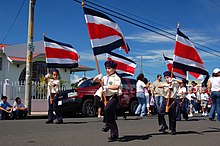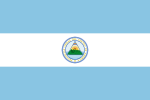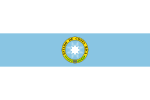Flag of Costa Rica
| Flag of Costa Rica | |
|---|---|
 |
|
| Vexillological symbol : |
|
| Aspect ratio: | 3: 5 |
| Officially accepted: | Similar design November 12, 1848 Current shape: May 5, 1998 |
The stripe sequence of the flag of Costa Rica was introduced on November 12, 1848. The current position of the coat of arms on the service flag and war flag corresponds to the requirement since November 27, 1906. The coat of arms was changed again on October 21, 1964 and May 5, 1998.
Description and meaning
The stripes of the national flag of Costa Rica are in the ratio 1: 1: 2: 1: 1. The flag emerged from the colors of the Central American Confederation (blue-white-blue), to which Costa Rica belonged until 1838, with white standing for the link between Central America and North and South America, and the two blue stripes the Caribbean Sea and the Pacific Symbolize the ocean that enclose the area.
In the front third of the middle stripe there is the national coat of arms in the service and war flags .
history
The first national flag of Costa Rica first appeared in September 1821 and already had two blue stripes that were supposed to represent the two oceans. Instead of the white central stripe used later, however, a yellow one was used, which supposedly represented the symbol for a "golden America". The flag was used in the struggle for independence from Mexico until May 1822 and again after independence on May 10, 1823 until June 6, 1823.
At this point, a complete change in design took place on short notice when an all-white flag was chosen that contained a red, six-pointed star. The spikes probably represented the six provinces that existed at the time. After Costa Rica joined the Central American Confederation, the Union flag was used from March 4, 1824, and its national coat of arms was added on November 2 of the same year. A change in the Union coat of arms on November 22, 1824 also led to a modification of the flag, which was continued after the Central American Confederation was dissolved in November 1838. From April 21, 1840, a new flag was used in addition to the former Union flag, in which the national colors were reversed and a new Costa Rican coat of arms was placed in the center of the flag. From November 15, 1840, this was the only national flag shown.
On April 20, 1842, however, they returned to the traditional colors of blue-white-blue and from September 1842 the national coat of arms from 1824 was placed in the center of the flag. During this time there was heated discussion about their appearance. In particular, the Liberal Party, which supported the French Revolution , advocated the addition of the color red in order to achieve a greater resemblance to the French tricolor . It was not until November 12, 1848, that the question was finally decided in favor of this three-color variant, when President José María Castro Madriz added a red median and a new national coat of arms. This was strongly influenced by his wife, who was also a supporter of the French Revolution.
Apart from a few minor changes, which mainly concerned the appearance of the coat of arms and its positioning, this has remained the valid national flag of Costa Rica to this day. Since 1906, the coat of arms has not been positioned centrally in the flag, but rather offset slightly towards the mast. In 1964 and 1998 the coat of arms and thus the service and war flags were changed in detail.
 ? September 1821 to June 6, 1823
? September 1821 to June 6, 1823
 ? June 6, 1823 to March 4, 1824
? June 6, 1823 to March 4, 1824
 ? March 4, 1824 to November 2, 1824
? March 4, 1824 to November 2, 1824
 ? November 2, 1824 to November 22, 1824
? November 2, 1824 to November 22, 1824
 ? November 22, 1824 to November 15, 1840
? November 22, 1824 to November 15, 1840
 ? April 21, 1840 to April 20, 1842
? April 21, 1840 to April 20, 1842
 ? September 1842 to November 12, 1848
? September 1842 to November 12, 1848
 ? November 12, 1848 to November 27, 1906
? November 12, 1848 to November 27, 1906
 ? November 27, 1906 to October 21, 1964
? November 27, 1906 to October 21, 1964
 ? October 21, 1964 to May 5, 1998
? October 21, 1964 to May 5, 1998
use
According to the law, citizens are only allowed to decorate their private houses with pennants in the national colors on public holidays. Even so, the national flag without its coat of arms, which is officially just the trade flag, is used practically by everyone and everywhere.
More flags of Costa Rica
see also: Flags and coats of arms of the provinces of Costa Rica
Both the seven provinces and the 81 cantons of Costa Rica have their own flags. In addition, the country's parties also use flags as a symbol of identification.
 ? Canton Desamparados until 2007
? Canton Desamparados until 2007
Vásquez de Coronado canton
Partido Democrata party
Party Partido Independiente
Trivia
The flag is similar in structure and color selection to the flag of Thailand , which was adopted eleven years after the flag of Costa Rica. The difference is the distribution of the red and blue stripes, which in Thailand is exactly the opposite of the Costa Rican flag.
Individual evidence
- ^ Smith / Neubecker: Coats of arms and flags of all nations. Munich 1981, ISBN 3-87045-183-1
- ↑ http://www.thailand-reisen.org/medien/flagge/
literature
- Smith / Neubecker: coats of arms and flags of all nations. Munich 1981, ISBN 3-87045-183-1
Web links
- Flags of the World - Costa Rica (English)


















